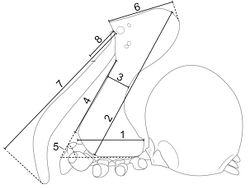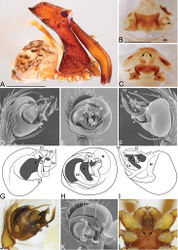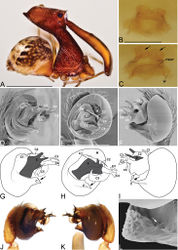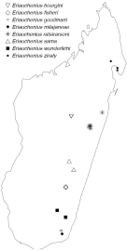Eriauchenius zirafy
| Notice: | This page is derived from the original publication listed below, whose author(s) should always be credited. Further contributors may edit and improve the content of this page and, consequently, need to be credited as well (see page history). Any assessment of factual correctness requires a careful review of the original article as well as of subsequent contributions.
If you are uncertain whether your planned contribution is correct or not, we suggest that you use the associated discussion page instead of editing the page directly. This page should be cited as follows (rationale):
Citation formats to copy and paste
BibTeX: @article{Wood2017ZooKeys, RIS/ Endnote: TY - JOUR Wikipedia/ Citizendium: <ref name="Wood2017ZooKeys">{{Citation See also the citation download page at the journal. |
Ordo: Araneae
Familia: Archaeidae
Genus: Eriauchenius
Name
Eriauchenius zirafy Wood & Scharff, 2017 sp. n. – Wikispecies link – ZooBank link – Pensoft Profile
Type material
Male holotype: MADAGASCAR, Toamasina, Parc National Masoala, 2 hour hike from Tompolo, 39 km SE Maroantsetra, 15°41'35.5"S, 49°58'22.5"E, 450 m, 15–17 Dec 2008, primary montane rainforest, general collecting day, beating vegetation, F. Alvarez-Padilla & H. Wood (deposited in USNM: USNMENT01377199).
Other material examined
MADGASCAR: Female paratype, Toamasina, Mikira forest, 2.5 hour hike from Andaparaty, 29 km N Maroantsetra, 15°12'2.95"S, 49°36'55.0"E, 195m, 10–12 Dec 2008, primary montane rainforest, beating vegetation: 5–10 feet above ground, F. Alvarez-Padilla & H. Wood (USNMENT01377190); 1M, same data as holotype (CASENT9028315); 1M,1J, Toamasina, Parc National Masoala, Ambohitsitondroina, Mt., Ambanizana, 15°34'9.9"S, 50°00'12.3"E, 650–700 m, 26–27 Feb 2003, rainforest, general collecting night, D. Andriamalala, D. Silva, et al. DSD0007 (CASENT9015571).
Etymology
The specific name is a noun in apposition; ‘zirafy’ means ‘giraffe’ in Malagasy.
Diagnosis
E. bourgini and E. zirafy sp. n. are distinguished from other “bourgini group” species by having two large protrusions on the crown of the cephalon (Fig. 22A). Females of E. bourgini and E. zirafy sp. n. are distinguished by the presence of two sclerotized invaginations on the bursa (Fig. 22C, arrows). Males of E. bourgini and E. zirafy sp. n. are distinguished by having a conductor with 4 processes in E. bourgini (Fig. 13D–K) and 5 in E. zirafy sp. n (Fig. 22D–K). Eriauchenius zirafy sp. n. is distinguished from E. bourgini by lacking posterior extensions on coxae I (Fig. 13L), and by having a cluster of small bumps and pores on the conductor base of the male pedipalp (Fig. 22G–I,L, arrow).
Description
Male holotype (USNMENT01377199, from Parc National Masoala, Madagascar). Total length 1.79, carapace 0.75 long, 0.70 wide. Abdomen 0.97 long, 0.81 high. Carapace tilt angle 59.5°, tilt height (CtH) 1.72, constriction 0.32, head length 0.86, neck length 0.89 (Fig. 2). CtH divided by carapace length 2.29. Cephalon with AME on large bulge. Cephalon with 4 small post-ocular spines on the crown of the cephalon, with the posterior pair on large protrusions and the anterior pair not on protrusions, and 1 small spine between the LE and AME (on each side, for a total of 2). Chelicerae 1.50 long, and with a short spine 0.68 from base of chelicerae, projecting downward. Femur I 1.89 long. Sternum 0.50 long, 0.32 wide. Carapace, chelicerae, and sternum dark reddish brown with white setae. Coxae and legs lighter brown, with darker annulations on tibiae and metatarsi. Abdomen mottled brown and beige, with a bright white patch on each lateral side, with tufts of white setae (Fig. 22A). Pedipalpal bulb with a small membranous sac above the embolus base, with the base of the conductor small and triangular with a cluster of small bumps and pores (Fig. 22G–I,L, arrow), and with the remainder of the conductor with 4 long processes as it wraps around the embolus, although one process is bifurcating (Fig. 22D,G–I, c3 and c4) for a total of five processes (Fig. 22D–I, c1–c5). The embolus is thick, contains two processes, and has membranous parts.
Female paratype (USNMENT01377190). This specimen is damaged due to fungus, rendering measurements and color descriptions of the abdomen impossible. Carapace 0.75 long, 0.70 wide. Carapace tilt angle 65.4°, tilt height (CtH) 1.72, constriction 0.31, head length 0.81, neck length 0.92. CtH divided by carapace length 2.29. Cephalon as in male. Chelicerae 1.66 long, and with small spine 0.73 from base of chelicerae. Femur I 1.90 long. Sternum 0.51 long, 0.33 wide. Carapace colors as in male. Female genitalia FSGP small and simple; unknown whether PB is present or absent due to specimen damage; bursa lacking poreplates and instead having a sclerotized invagination on each side of the bursa anterior (Fig. 22C, arrows).
Variation
Total length 1.79–1.80 (males; n=3); Carapace length 0.72–0.75 (males; n=3); Femur I 2.54–2.72 times the length of carapace in males (n=3) and 2.54 times the length of the carapace in females (n=1). CtH divided by carapace length 2.29–2.44 in males (n=3). Average femur I length 1.96 (males; n=3).
Natural history
Specimens were collected from 195–700 m in elevation in rainforest by beating vegetation and general collecting.
Distribution
Known only from areas around Parc National Masoala in northeastern Madagascar (Fig. 31).
Original Description
- Wood, H; Scharff, N; 2017: A review of the Madagascan pelican spiders of the genera Eriauchenius O. Pickard-Cambridge, 1881 and Madagascarchaea gen. n. (Araneae, Archaeidae) ZooKeys, (727): 1-96. doi
Images
|



